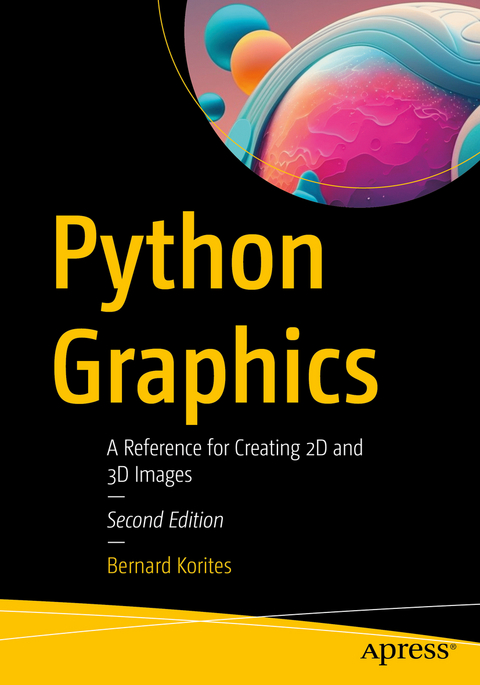
Python Graphics
Apress (Verlag)
978-1-4842-9659-2 (ISBN)
Also brand new to this edition are demonstrations on how to visualize electron probability clouds around a nucleus, climate change, ecological diversity, population dynamics, and resource management. Python source code, including detailed explanations, is included for all applications, making the book more accessible to novice Python programmers.
After completing this book, you will be able to create compelling graphic images without being limited to functions available in existing Python libraries.
What You Will Learn
- Create 2D and 3D graphic images
- Add text and symbols to images
- Shade 3D objects
- Display cast shadows
- Use color for maximum effect
- View 2D and 3D data sets
- Fit lines and curves to data sets
Who This Book Is For
Python developers, scientists, engineers, and students who use Python to produce technical illustrations and display and analyze data sets. Assumes familiarity with vectors, matrices, geometry and trigonometry.Dr. Bernard J. Korites holds degree from Tufts and Yale. He has been involved in engineering and scientific applications of computers for his entire career. He has been an educator, consultant, and author of more than ten books on geometric modeling, computer graphics, simulation of physical processes, and the application of computers in science and engineering. He has been employed by Northrop Aviation, the Woods Hole Oceanographic Institute, Arthur D. Little, and Itek. He has consulted for the US Navy, Aberdeen Proving Grounds, and others. He was Chief Engineer on an expedition to take the longest sediment core sample in the North Atlantic aboard the Canadian Icebreaker John Cabot. He has made numerous dives aboard the submersible Alvin and has spent time aboard the USBCF Albatross. Early in his Career, he developed software to find physical interference between systems of solid objects. This found wide application in the design of power plants, submarines, and other systems with densely packed spaces.
lt;b>Chapter 1: Essential Python Commands and FunctionsProgramming style, the plotting area, Size of the plotting area, importing plottingcommands, displaying the plotting area, the plotting grid, saving a plot, grid color,tick marks, custom grid lines, labelling the axes, plot title, colors - mixing, intensity,overplotting, background color, plotting area shape, correcting shape distortions, coordinate exes, commonly used plotting commands and functions, point, dots, lines,arrows, text in plots, lists, tuples and arrays.
Chapter 2: Graphics in Two DimensionsMaking lines from dots, dot art, circular arcs from dots, circular arcs from line segments, circles, dot circles, ellipses, 2D translation, 2D rotation.
Chapter 3: Graphics in Three DimensionsThe 3-dimensional coordinate system, projections onto the coordinate planes, rotationsaround the y, x and z directions, separate rotations around the coordinate directions,sequential rotations around the coordinate directions, matrix concatenation, keyboarddata entry with functional program structure.
Chapter 4: Perspective3D objects with perspective transformation.
Chapter 5: Intersections
3D Lines intersecting 3D rectangular plane, triangular planes, circle, circular sector,sphere, plane intersecting a sphere.
Chapter 6: Hidden Line Removalbox, pyramid, planes, sphere.
Chapter 7: ShadingShading a box, a sphere.
Chapter 8: 2D Data PlottingLinear regression, function fitting, splines.
Chapter 9: 3D Data Plotting3D surfaces, surface shading.
Chapter 10: Demonstration - Saturn
Chapter 11: Demonstration - The Sunsolar radiation, photons and the Sun, Max Planck's black body radiation, the Sun'stotal power output, Earth's irradiance, the Sun Earth model.
Chapter 12: Demonstration - Electron Probability Clouds
Chapter 13: Demonstration - Climate Change
Chapter 14: Demonstration - Ecological Diversity
Chapter 15: Demonstration - Population Dynamics
Chapter 16: Demonstration - Resource Management
Chapter 17: Demonstration - More Images of Saturn
Appendix A: Where to Get Python
Appendix B: Planck's Radiation Law and the Stefan-Boltzmann Equation
Appendix C: A Primer on Python Programming
Appendix D: Standard Python Programming Functions
| Erscheinungsdatum | 02.12.2023 |
|---|---|
| Zusatzinfo | 162 Illustrations, color; 36 Illustrations, black and white; XVII, 488 p. 198 illus., 162 illus. in color. |
| Verlagsort | Berkley |
| Sprache | englisch |
| Maße | 178 x 254 mm |
| Themenwelt | Informatik ► Programmiersprachen / -werkzeuge ► Python |
| Mathematik / Informatik ► Informatik ► Software Entwicklung | |
| Schlagworte | 2-dimensional computer graphics • 3D graphics • 3-dimensional computer graphics • curve fitting • graphics programming • images • matrices • Python Graphics • Shading • Stereographic Transformations • Surface Patches • Surface Regression • Vectors |
| ISBN-10 | 1-4842-9659-1 / 1484296591 |
| ISBN-13 | 978-1-4842-9659-2 / 9781484296592 |
| Zustand | Neuware |
| Informationen gemäß Produktsicherheitsverordnung (GPSR) | |
| Haben Sie eine Frage zum Produkt? |
aus dem Bereich


